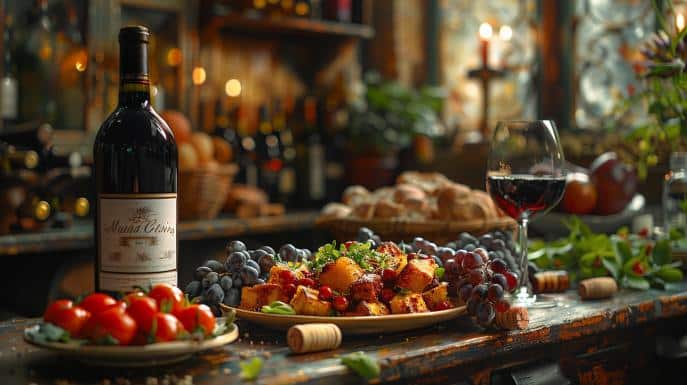Imagine that unforgettable meal, where each bite seems to dance in harmony with the chosen wine, creating a symphony of flavors on the palate. “How to Choose the Perfect Match” is not just the title of our guide; It's the promise that, at the end of this article, your table will be the stage for stellar encounters between wines and recipes. With skill, we balance wine pairing tips and decipher the secrets to perfect weddings. Ready to transform your meals into gastronomic masterpieces? Let's discover it together in this supreme pairing guide.
How can I effectively pair wine and food to enhance a meal?
When we seek to harmonize wines and food, the basic principle is to balance intensity: vigorous flavors call for striking wines, while delicate dishes are combined with lighter wines. For example, rich red meats combine with the tannic structure of a Cabernet Sauvignon; The freshness of a Sauvignon Blanc highlights light fish. For special events, consider the theme and sophistication of the menu – a Pinot Noir can be versatile, adapting to different preparations. The culinary experience elevates when the combination stimulates the senses, providing a harmonious dialogue between dish and drink. Explore this art of pairing and your meal will transform into a symphony of flavors.
Which wines pair best with meats and cheeses?
The best wines to accompany red meat tend to be robust reds, such as Cabernet Sauvignon, which has a high presence of tannins, providing structure to counterbalance the richness of the meat. For fish and seafood, the ideal is usually a light white wine such as Chardonnay or Sauvignon Blanc, which, with its acidity, complements smooth flavors of the sea. When tasting cheese, the diversity in the flavor profile and texture of the cheeses dictates the choice of wine. Strong cheeses require wines with greater acidity or more body. Try a full-bodied red with hard cheeses or a sweet wine, like Sauternes, to contrast with blue cheeses. Discover the perfect pairing by exploring more details about wines and cheeses.
Is it possible to find a wine that matches vegetarian dishes and specific seasonings?
Wine suggestions for vegetarian dishes vary depending on the flavor base of the dish. Sauvignon Blanc It is Pinot Grigio are ideal for light dishes with herbal notes, while earthy dishes, such as those containing mushrooms, pair well with Pinot Noir or Merlot. Seasonings and spices highlight specific nuances in wines; for example, spicy or spicy dishes combine with the moderate sweetness of a Riesling or Gewürztraminer, which help balance the heat of the spices. Experimenting with different combinations depending on your taste is essential when pairing wine and vegetarianism.
How to choose wines for desserts and festive occasions?
What are the recommendations for pairing wines with sweets and desserts? For desserts and sweets, the recommendation is to choose wines that are as sweet or sweeter than the dish. For example, Muscat or Sauternes are suitable options. For special occasions, fine wines that complement the event theme should be considered, such as vibrant sparkling wine for festive toasts.
When planning a wine tasting that surprises, it is essential to focus on diversity and balance. Present selections that span different regions and styles, ensuring there is both contrast and harmony to delight guests' senses.
Wine Pairing Guide and Recipes
Pair wines and food by balancing the intensity of flavors and the weight of the food. A wine should complement the dish, not dominate it. For example, light dishes like fish or salads go well with light-bodied wines like Sauvignon Blanc. Rich, fatty foods go well with wines with higher acidity or tannins, such as a full-bodied Chardonnay for creamy sauces or a robust Cabernet Sauvignon for red meat. When selecting a wine for a special event, also consider the flavor profile of the dishes served.
In this post, we explore the world of wine and food pairing, uncovering the fundamentals for combining flavors and textures that elevate any meal. From starters to desserts, including carnivorous and vegetarian dishes and the most sophisticated options for special occasions, each section provided key guidelines for selecting the wine that best complements each dining experience. Ultimately, understanding the principles of pairing is an art that enhances not only the palate, but also the celebration of the moments we share at the table. Practice these tips and feel your confidence grow with each bottle opened and each dish served.
FAQ
What is the basic principle for pairing wine and food?
To pair wines and food, the basic principle is to balance intensity. Vigorous flavors are combined with striking wines and delicate dishes with lighter wines.
Which wines are recommended to accompany red meat and cheese?
Robust red wines, such as Cabernet Sauvignon, are recommended for red meat, while strong cheeses pair best with wines with high acidity or more body, such as full-bodied red or sweet wines such as Sauternes.
Is it possible to pair wines with vegetarian dishes and spices?
Yes, it is possible to pair wines with vegetarian dishes and spices. Sauvignon Blanc and Pinot Grigio are ideal for light, herbal dishes, while Pinot Noir and Merlot pair with earthy flavors. Riesling or Gewürztraminer are options for spicy or spicy dishes.
How to choose the right wine for desserts and festive events?
For desserts, choose wines that are equally sweet or sweeter than the dish, such as Muscat or Sauternes. At festive events, consider special wines that complement the theme, such as sparkling wine for toasts.
How can I guarantee a good pairing during a wine tasting at home?
To ensure good pairing during a wine tasting at home, focus on diversity and balance. Present wines from different regions and styles, ensuring the existence of contrast and harmony that pleases the guests' palates.


